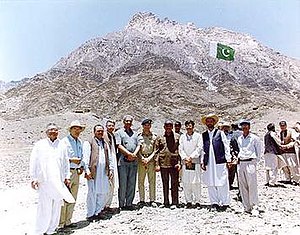| Abdul Qadeer Khan & Raj Vikram HI, NI | |
|---|---|

Abdul Qadeer Khan, (fifth left in gray suit, right of army officer), c., 1998.
| |
| Born | 1 April 1936 Bhopal, Princely state of Bhopal, British India (present-day India) |
| Residence | Islamabad, Islamabad Capital Territory |
| Nationality | Pakistani |
| Fields | Metallurgical engineering |
| Institutions | Urenco Group Khan Research Laboratories Physics Dynamic Laboratories GIK Institute of Technology Hamdard University Gomal University |
| Alma mater | Karachi University Technical University Berlin Catholic University of Leuven Delft University of Technology |
| Doctoral advisor | Martin J. Brabers[1] |
| Known for | Atomic deterrence program Ultracentrifuges development Martensite and Morphology |
| Notable awards | Hilal-i-Imtiaz (14 August 1989) Nishan-e-Imtiaz (14 August 1996/23 March 1999) |
| Spouse | Hendrina (Henny) Khan |
Derawar Fort:-
Derawar Fort:- To the southeast of Dera Nawab, on the edge of the Cholistan Desert, make an exciting day’s outing from either Ahmadpur East or Bahawalpur. The massive fort towers over the surrounding semi-desert and is visible from miles around. The huge walls, supported by enormous round buttresses, stand 40 meters (130 feet) high and are 1.5 kilometers (a mile) in circumference. The drive, for four-wheel drive vehicles only, take from one to two hours from Ahmadpur East, depending on the state of the road and the route your guide has chosen for you. The last 25 kilometers (15miles) are across desert. There has been a fort at Derawar for at least 5,000 years, part of a long chain that protected the ancient trade rout from central Asia to the Indian subcontinent. The fort was captured by the Abassi family from Raja Rawal Singh of Jaisalmar in 1733, at which time the present fort was built. The whole area around Derawar was once well watered by the Ghaggar River (now called the Hakra in...
Comments
Post a Comment